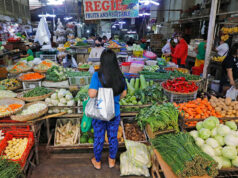Inflation picks up in Nov., but on target — PSA, BSP
INFLATION inched up to 1.3% in November following five straight months of easing, the Philippine Statistics Authority (PSA) reported on Thursday.
November’s headline inflation rate was up from 0.8% in October, albeit slower than the six-percent inflation rate posted in November 2018.
The reading was higher than the 1.2% median estimate in BusinessWorld’s poll of 16 economists last week but fell within the Bangko Sentral ng Pilipinas’ (BSP) 0.9%-1.7% range for the month.
The overall rise in prices of widely used goods averaged 2.5% in the 11 months to November compared to the BSP’s 2.4% forecast and 2-4% target range for 2019.
Stripping out volatile energy and food prices, core inflation steadied at 2.6% in November. Year-to-date, it averaged 3.3%.
The Bangko Sentral ng Pilipinas (BSP), which last week signaled that it would watch out for this latest inflation data, said in a statement yesterday that it “will consider all the latest economic developments here and abroad in the Monetary Board’s policy meeting on Dec. 12 to ensure that monetary policy stance remains consistent with the BSP’s price stability objective while being supportive of economic growth.”
The PSA attributed the latest inflation result to higher annual increases in the following commodity groups: alcoholic beverages and tobacco (17.6% from 16.5% in October); housing, water, electricity, gas and other fuels (1.2% from 0.6%); health (3.1% from 2.9%); and communication (0.3% from 0.2%).
The National Economic and Development Authority (NEDA) said in a statement that November inflation was “mainly driven” by faster prices of fish, the “slower deflation” in rice and electricity, gas and other fuels, and the “waning base effects” from last year.
The heavily weighted food and non-alcoholic beverages index was flat in November versus October’s 0.9% dip.
Food-alone inflation continued to decline by 0.2% in November, but was slower than October’s 1.3% contraction.
Performance among food groups varied, with some exhibiting faster price increases while others posted slower declines. Rice, which saw a 9.7% contraction in October, continued to decline albeit at a slower rate of 8.3% in November.
Price increases in fish and meat accelerated to 2.5% (from 0.8%) and 3.2% (from 2.7%), respectively. Vegetables likewise picked up by one percent from a 0.8% decline previously.
Economists interviewed said that November’s inflation data means the BSP will likely will likely resume monetary policy easing in the first quarter of 2020.
“UnionBank’s Economic Research Unit sees that there is ample traction for another rate cut, but the BSP Governor [Benjamin E. Diokno] himself did cite the impact of volatile global oil prices, which is very critical to inflation’s longer-term prospects. Thus, the BSP is expected to continue easing next year and that this year’s easing cycle is already done,” UnionBank of the Philippines, Inc. Chief Economist Ruben Carlo O. Asuncion said in an e-mail.
ING Bank N.V. Manila Senior Economist Nicholas Antonio T. Mapa expects the BSP to hold fire in its Dec. 12 policy review.
Mr. Mapa noted, however, that given Mr. Diokno’s “dovish leaning,” the rate cut cycle may resume as early as the first quarter next year.
“The peso may recover in the short-term as faster inflation will mean that a BSP rate cut is off the table for now,” he added.
JPMorgan Chase Bank NA Singapore Branch Economist Nur Raisah Rasid expected the same: “Amid ongoing growth concerns and a well behaved CPI (consumer price index) trajectory, we continue to expect 25 [basis points or bps] policy easing in [the first quarter of 2020],” she said in a note.
In a separate note, Capital Economics Asia Economist Alex Holmes expected “more easing” in 2020 “with economic growth set to fall short of the government’s 6.5%-7.5% forecast for next year and with inflation likely to remain well within target.”
“We are sticking with our view that the central bank will cut rates by a further 50 bps in 2020…” he said.
BSP’s Mr. Diokno has said early last month that the BSP was done with its policy easing cycle for this year after cutting benchmark interest rates by a total of 75 bps and banks’ reserve requirement ratio by a total of 400 bps.
INFLATION OUTLOOK
“The latest inflation outturn remains consistent with the BSP’s prevailing assessment that inflation has bottomed out in October and is expected to gradually approach the midpoint of the target range [of 2-4%] in 2020 and 2021,” the BSP said in its statement.
Meanwhile, JPMorgan’s Ms. Rasid said in a note that inflation will “likely trend higher” in the coming months “in part reflecting the implementation of higher excise taxes on tobacco and alcoholic beverages from January next year.”
“Headline CPI will likely average 2.4% in [the first half of 2020], and a rise to 3.1% in the [second-half]. The CPI profile suggests that inflation will likely remain comfortably within the BSP’s 2-4% target range through 2020,” she added.
UnionBank’s Mr. Asuncion said the inflation print in December is “expected to be more than one-percent as well” with full-year 2019 inflation expected to settle at 2.4%.
For his part, ING Bank’s Mr. Mapa said that the acceleration in inflation would continue to pick up going into 2020 and “settle at around 3% throughout the most part of next year.”
“For as long as supply conditions remain favorable, we can expect inflation to remain in-check, however, we are unlikely to visit the sub-2% level for at least the next 12 months,” he added. — Edwin C. Aruta, Jr.



